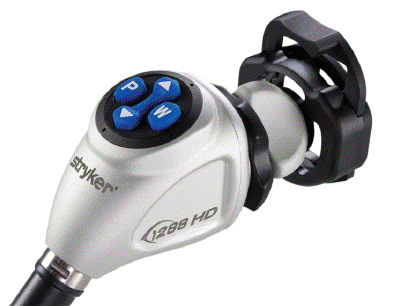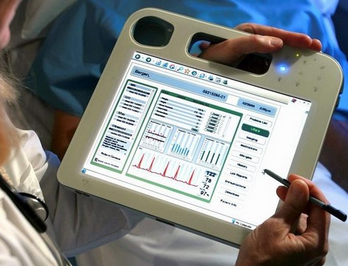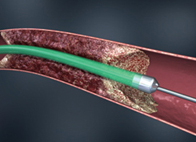Most of the medical advances that we have seen have been with pharmaceuticals, as drug companies compete to introduce new more effective drugs because the patents on many blockbuster drugs are about to expire. But the coolest advances have to do with medical equipment. The age of high-tech medicine is here with even greater advances in development.
Len Calderone
Ekso Bionics’ exoskeleton is an outgrowth of military technology that allows seriously disabled people to stand and walk again. Ekso has created an exoskeleton product called eLegs that literally gets these people up and walking. Arm swings on crutches control the legs and tell them when to walk. Technology like this may eliminate the concept of a wheelchair for millions of people with spinal cord injuries, stroke, and MS, as the exoskeleton is a passive robot that does all of the work. Once strapped in the patient resembles an action figure right out of the movies. The system is very costly and not covered by insurance yet, so it is used mostly for therapy, but with proposed innovations, it will become more main stream within the next ten years.
Recently, I did an article about 3D printers, where a printer could replicate anything by reconstituting raw material into the object desired. We now see this technology adapted to print a solution of living skin cells directly onto wounds, eliminating the need for skin grafts and greatly accelerating the healing process. The skin bio-printer uses the patient as the paper, while it prints out instant skin.

The proposal is for a unit that would use two print heads to eject a mixture of fibrinogen, collagen and thrombin, which together cause blood coagulation and form connective tissue. These are applied to the wound along with fresh skin cells, closing off the wound once the magic happens. The skin bio-printer is still in the development stage.

The Skin Cell gun is very similar in concept to the Skin Bio-Printer. The idea is to create a mixture of the patients’ own skin stem cells and spray them onto a severe burn wound. The Skin Cell Gun can heal second degree burns completely, and within only a few days. This is great news for burn victims, who are left horribly vulnerable without the skin’s protection if left unhealed too long.
Until now burns have usually been treated with skin grafts, which involve taking skin sections from uninjured parts of the patient’s body, or growing sheets of skin artificially, and grafting them over the burn. The grafts can take several weeks or even months to heal, and during the recovery period, patients are prone to infections because of the damage to the skin. After treatment the wound heals in just days, when it would have taken weeks to heal using traditional treatments
By combining two well-known medical examination methods: SAXS (Small-Angle X-ray Scattering) and CT-scanning (computed tomography scanning), researchers are able to check the myelin sheaths covering nerve cells. Studying the changes in myelin sheaths will help in better understanding of conditions such as multiple sclerosis and Alzheimer's disease.
Bioengineered blood vessels may revolutionize bypass & hemodialysis surgeries. Biotech work with Humacyte uses donor cells stuffed into polyglycolic acid scaffolds and placed in a bioreactor, resulting in collagen constructs resembling blood vessels. In addition, the risk of a patient's body rejecting such implants is greatly minimized. Though currently in nascent stages, this development means some amazing, revolutionary things for patients and doctors with various arterial diseases and conditions. Even after refrigeration for years, the tubes still function in a similar manner to organic veins, arteries and capillaries. Transplants involving artificial polytetraflourethylene (Teflon) replacements oftentimes require repair or replacement after 10 months, making this awe-inducing research all the more attractive and optimistic.
 A bio-engineered bandage (GEBB) that might one day allow doctors to bypass blocked arteries or help surgical incisions or wounds heal quicker with less scarring is under development at the University of Illinois. Dubbed a "microvascular (smaller vessels) stamp," the bandage spurs the development of blood vessels, a process known as "vascularization," in defined patterns. The stamp carries out its work by delivering protein molecules called growth factors to areas on tissue that need blood vessels.
A bio-engineered bandage (GEBB) that might one day allow doctors to bypass blocked arteries or help surgical incisions or wounds heal quicker with less scarring is under development at the University of Illinois. Dubbed a "microvascular (smaller vessels) stamp," the bandage spurs the development of blood vessels, a process known as "vascularization," in defined patterns. The stamp carries out its work by delivering protein molecules called growth factors to areas on tissue that need blood vessels.
Measuring roughly one centimeter across, the stamp is created from a hydrogel made from polyethylene glycol and methacrylic alginate. Polyethylene glycol is a polymer the U.S. Food and Drug Administration has approved for use in laxatives and other pharmaceutical products. Methacrylic alginate is an edible material similar to gelatin. The bandage may also be used for wound healing, diabetes, and to replace faulty tissues.
As physicians use tablets more frequently on the job, they’ll be receptive to apps that make their jobs easier, more efficient, and more accurate. AliveCor unveiled its ECG app, which turns an iPad into an electrocardiogram device. Physicians can measure a heartbeat by simply pressing the iPad against a patient’s chest.
3D has a place outside of the movies and into the operating room. Using the same technology that helped avatars jump through the screen at the movies, surgeons can insert a 3-dimensional endoscope through a patient's nose. Then, when they put on polarized glasses, they see a 3-D view of the brain. Surgeons can now remove a tumor without damaging the brain or the optic nerves.

A groundbreaking new development of Stryker’s HD 3-Chip endoscopy camera is its ability to allow for wireless transmission capabilities in the operating room when used with the Stryker WiSe wireless flat panel monitor. The 1288 HD 3-Chip Camera features a 1920x1080p resolution and nine specialty settings, resulting in optimum color resolution and brightness.

Intel introduced the Mobile Clinical Assistant, which picks up where the general purpose laptop leaves off. Along with appropriate software, it enables nurses and doctors to chart and check information at the bedside. A built-in barcode scanner can match each patient with the treatment being delivered, helping reduce medication administration errors. A radio frequency identification (RFID) scanner lets nurses identify patients and verify authorized care providers. An integrated digital camera allows detailed enhanced chart documentation of wounds, surgical sites, range of motion, and other items. Photos can be placed directly into the patient's electronic medical record. Built-in support for Wi-Fi and Bluetooth technology connects to wireless area networks and enables automatic uploads of a patient’s vital signs and other data into the electronic medical record.

The MEDIWRAP® blanket assists in the maintenance of a normal state of temperature without the need for external heat sources or additional bedding and is ideally suited for use before, during and after surgery. It helps to maintain a stable environment for the transfer of critically ill patients and acts as a total barrier to bacteria, protecting staff and vulnerable patients from cross infection. The compact, lightweight blanket holds heat and has an absorbent inner lining with a wind and waterproof outer material. Designed for EMTs, it is available for home use as well.
Remember the movie “Fantastic Voyage” where a miniature submarine is fed through a patient’s blood stream? Well, this technology might be closer than we know. Electrical engineer Ada Poon (Stanford School of Engineering) demonstrated a tiny, wirelessly powered, self-propelled medical device capable of controlled motion through a fluid - blood more specifically. Medical devices can be implanted or injected into the human body and powered wirelessly using electromagnetic radio waves. No batteries to wear out. No cables to provide power. Such devices could revolutionize medical technology. These devices could travel through the bloodstream to deliver drugs, perform analyses, and perhaps even zap blood clots or removing plaque from sclerotic arteries.

A radio transmitter outside the body sends signals to an independent device inside the body that picks up the signal with an antenna of coiled wire. The transmitter and the antenna are magnetically coupled such that any change in current flow in the transmitter produces a voltage in the coiled wire, or more accurately, it induces a voltage. The power is transferred wirelessly. The electricity runs electronics on the device and propels it through the bloodstream.

Currently, about 5 million Americans have heart failure. Unfortunately, there are less than 3,000 donor organs available worldwide per year; therefore the overall mortality rate due to end-stage heart failure remains high. With product attributes specifically developed to minimize the risk of complications, the HeartMate II by Thoratec is exceptionally durable, dependable, and thromboresistant (resistance by a blood vessel to thrombus formation) left ventricular assist device.
Designed to dramatically improve survival and quality of life, the HeartMate II was developed with the goal of providing several years of circulatory support for a broad range of advanced heart failure patients. Its small size and quiet operation makes the HeartMate II suitable for a wider range of patients, including women and those of smaller stature. Implantation of the device requires a less invasive surgical procedure.
Management is relatively easy with a completely wearable system and Low-dose anticoagulation regimen. Improvement of hemodynamics (the study of the physical aspects of blood circulation) prior to cardiac transplantation can help optimize long-term outcomes.
 Blocked arteries in the legs, or peripheral arterial disease (PAD), affect one in five men and one in eight women aged over 50. In many cases, PAD results in amputation, mostly in diabetics with poor blood circulation. The usual treatment is to insert a thin tube into the main artery in the thigh and feed through a wire to try to break through the blockage. But if the deposit has hardened, the wire often cannot penetrate, and patients face surgery or amputation. Now there is a pneumatic drill that can clear blocked arteries.
Blocked arteries in the legs, or peripheral arterial disease (PAD), affect one in five men and one in eight women aged over 50. In many cases, PAD results in amputation, mostly in diabetics with poor blood circulation. The usual treatment is to insert a thin tube into the main artery in the thigh and feed through a wire to try to break through the blockage. But if the deposit has hardened, the wire often cannot penetrate, and patients face surgery or amputation. Now there is a pneumatic drill that can clear blocked arteries.
The CROSSER Catheter system is revolutionizing treatment of Chronic Total Occlusions (CTOs) or blockages that have completely closed off circulation in arteries in the heart or legs. It is a tiny vibrating device that breaks up hard deposits in leg arteries. The tip of the wire on the new device vibrates 20,000 times a second. This punches a hole through the middle of the deposit, allowing doctors to inflate a tiny balloon to displace the blockage.
As we look back on science fiction stories with fantastic medical concepts, we can see that almost nothing is impossible in medicine given sufficient time and money. As our population becomes grayer, we will see new advances almost daily.
The content & opinions in this article are the author’s and do not necessarily represent the views of RoboticsTomorrow
Comments (0)
This post does not have any comments. Be the first to leave a comment below.
Featured Product


